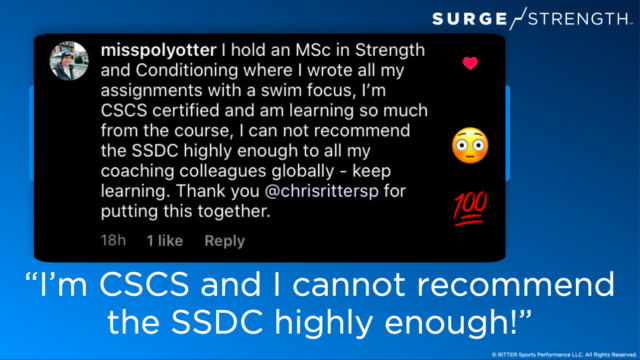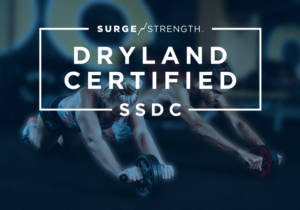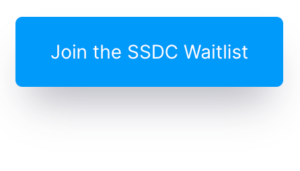Coaching dryland workouts for college swimmers can have many different variables to navigate. Even though swimmers may have very similar race times, their dryland experience varies greatly. On top of that, there is typically an entire strength and conditioning staff solely dedicated to dryland in the weight room. This removes the swim coach from the driver’s seat of an important aspect of training. Having a specialist take over dryland at this level can be beneficial for everyone involved if communication lines stay open and strong. However, sometimes swim coaches and strength coaches aren’t always on the same page. Other times swim coaches just need a little extra deck work to supplement the rest of their program.
This is where SURGE Strength bridges the gap and is raising the standard in dryland training for swimming. Our Dryland Certified Coaches have the top credentials for strength & conditioning for swimmers (SURGE Strength Dryland Certified (SSDC). In fact, many coaches who already have their CSCS (NSCA Certified Strength & Conditioning Specialist) are saying that becoming SURGE Strength Dryland Certified (SSDC) was even more helpful in their programming of dryland workouts for swimmers than their entire degree. We don’t take this compliment lightly.

College programs vary in the number of resources and staff allotted to each. Situations may and do vary. But oftentimes, swim coaches have access to strength & conditioning coaches for their program. It’s important to get that relationship working well. Being able to communicate about strength & conditioning principles as it relates specifically for dryland workouts for swimmers will help develop rapport. This is how our SURGE Strength Dryland Certified Coaches recommend approaching a collegiate dryland program:
1) Relate to Your Strength Staff
Lack of communication between coaching staff is often the biggest barrier to success in dryland workouts for college swimmers. It is a disservice to your athletes. Strength & conditioning coaches are hired to support your swim program. They are experts at tailoring a weight room program to match your programming in the pool. The best way to get the most benefit out of their expertise is to explain your swim plan in terms they understand. Check-in with them often. Strength coaches are usually eager to share their craft. They enjoy taking coaches through their reasoning. If you still aren’t clicking with your strength coach, we’d recommend you educate yourself more on strength & conditioning so you can better relate to your program’s strength coaches.
If this feels like a tall order, don’t sweat it. Expanding your strength and conditioning vocabulary could be as simple as listening to the SURGE Strength Podcast, or taking a FREE Dryland 101 Course in the SURGE Strength Academy. Here are past articles with more dryland education resources and recommendations:
- Learn More: Coaching the Dryland Coach Within You: A Guide for Swim Coaches
- Learn More: Dryland Education: 4 FREE Resources from SURGE Strength
2) Boundaries with Your Strength Staff
Next, establish expectations and boundaries with your strength and conditioning coaches. Listen to their big-picture approach and trust their process. At the same time, establish which exercises swimmers will be performing in the weight room, and which exercises they can do with you. Remember that, like you, it’s likely that your strength coaches are pressed for time. Suggest implementing some of the resistance training principles they would normally do with a strength coach into a wetland workout in conjunction with a swim practice. For example, mobility work, reaction games, or function exercises may work to your advantage within a swim practice. Communicating this to the strength coach makes weight room sessions more efficient.
Let’s imagine that your relationship with your strength coach is less than ideal. Maybe you feel that the coach isn’t truly invested in your swimmers or lacks knowledge of the sport. Perhaps your strength coach isn’t challenging them in the way you think is best. You can still have a successful, comprehensive dryland program. Save the basic weight training movements such as weighted squats and deadlifts for the strength and conditioning program. This is a strength coach’s bread and butter.
Instead, supplement short, 15-30-minute dryland sessions into the beginning or end of swim practice. Focus these sessions on building swim-specific athleticism. This is where your skills as a swim coach come out in dryland. Short, appropriate dryland sessions are a fun and effective way to break up the monotony of repetitive yardage, especially mid-season. In turn, you will notice better results in the weight room as well as in the pool. Communicate this change in programming with your strength coach – explain why you’ve chosen these certain dryland exercises to be done on deck. And, emphasize that the core strength and conditioning is left to their expertise.
3) Know Your Athletes
Once you establish your role in the collegiate dryland plan, you can assess the athletes to better create dryland workouts for college swimmers. Each swimmer at the collegiate level brings an athletic background or lack thereof with them to college. Some swimmers have been doing dryland since they can remember. Others may have never touched a weight. Consider their training age when building a dryland plan. Communicate your athletes’ history to your strength and conditioning staff. Remember that you are their first advocates, as you likely spend more time with your athletes than the strength and conditioning staff.
4) Understand Your Program
There are many variables your athletes are trying to manage, and lots are variables that they’re encountering for the very first time; schoolwork, living without parents, and the general transition to adulthood can really stress out your swimmers. Keep your program as simple as possible to offset some of this stress. Give them a structure to depend on when other aspects of their lives are changing so drastically. You will get a better effort from your athletes. A simple program also allows you to scale it better for individual training ages within your team.
5) Coach Smarter, Not Harder
Coaches also have many factors to juggle within a swim season and worrying about dryland workouts for college swimmers can sometimes take a backseat. Keeping dryland simple or delegating it out to the assistant coach or GA may be the best option. Investing time into dryland education in the off-season will also serve you and your staff when it’s time to focus on recruiting and coaching swim practice. Most of all, having a game plan laid out ahead of time will exponentially increase its success.
6) Build Buy-In
Keep in mind that everyone on your team has decided to be an elite swimmer to some respect. You are coaching adults who can easily decide to quit or drop out at any point, especially at the DIII level (since scholarships aren’t part of the deal, and the intangible benefits take much more of a front seat). More importantly, you will find differing levels of individual commitment within your team. Some students may want to qualify for NCAA’s. Others may just want to enjoy competing at dual meets. To manage this, build buy-in with your athletes. Dryland is a great opportunity to bond as a team and make memories together. Get creative and use this time to build cohesiveness and commitment within your team.
Conclusions in Navigating Dryland Workouts for College Swimmers
Keep in mind that collegiate dryland isn’t always the end of the road for your swimmers. Many swimmers are now peaking after college, so dryland workouts for college swimmers aren’t even the “pinnacle” of their dryland training. Others go on to qualify for trials or compete in master’s programs. Continue to slow cook the process with dryland. Use your school’s strength and conditioning program to your advantage. Communicate your concerns and find your lane for dryland programming. Then, find fun and creative ways to implement dryland principles into your swim program. A simple dryland program will allow swimmers to execute it well and stay engaged in their experience. Collegiate dryland leaves a lasting impression on your swimmers as they embark on the next chapter of their swim careers and lives, and that is a wonderful outcome for them both as athletes and people.
ENROLL IN A DRYLAND 101 COURSE FOR FREE
MORE DRYLAND RESOURCES FROM SURGE STRENGTH:
GET STARTED WITH A DRYLAND PROGRAM
LEARN ABOUT BECOMING SSDC

SURGE Strength’s Mission:
BUILD BETTER ATHLETES
GENERATE FASTER SWIMMERS
Courtesy of SwimSwam’s exclusive dryland training partner, SURGE Strength.
SURGE Strength, a strength training brand created by Chris Ritter, CEO of RITTER Sports Performance, aims to build better athletes and faster swimmers through dryland programs and educational courses.
Get started with a SURGE Strength Dryland Program or enroll in a dryland course in the SURGE Strength Academy today!










